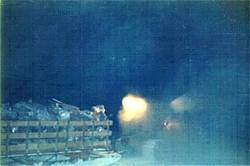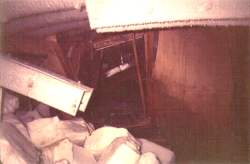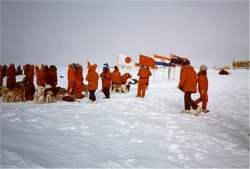
This was the normal method of getting rid of trash at South Pole until a few years ago. The dump was downwind of the summer camp, where trenches were dug in the snow for burying the waste. During the summer, the forklifts frequently hauled buckets of trash out of the dome, the arches, and other work areas. During my winter we kept this trash sled in the helium arch so that we would not have to dig out the front door of the station. About every month or so we would haul the sled out to the dump. No effort was made to separate or recycle anything.
The "South Pole Dump" was closed in March, 1991, when the station started to separate all waste products and prepare them for shipment to McMurdo. A concurrent effort has been made to minimize the shipment of potential waste products to the station, and to reuse as much as possible. As the new station is constructed, the old station buildings and the dome will also be dismantled and shipped out...

In 1988 the arch of the newer station was showing signs of distress, and the purpose of my visit was to evaluate its life expectancy. I predicted that the new station would start to go "crunch" in March of 1990. Since NSF had abandoned the station by then, the Siple II arch probably looks worse than this picture.
The "flavor" of the environmental protocol calls for removal and retrograde of old stations "where practicable." This one, like Byrd, will probably never be recovered. Two of the other US stations, Little America and Ellsworth, were constructed on ice shelves which have since broken away carrying the remains of these facilities to a watery disposal site somewhere north of Antarctica.

South Pole residents greet Will Steger, his Transantarctic expedition, and his friendly sled dogs in December, 1989. The US never made much use of dog teams for exploration, but the British, Australian and New Zealand programs used them extensively, particularly around the Peninsula and on the other side of the continent. Unlike snow machines or more sophisticated vehicles, dogs never required refueling or repairs, they frequently created more of themeselves, they were usually lovable, and seal or penguin meat for them was usually available along the coast. However, in an effort to reduce potential disease impact to the native Antarctic populations, the treaty nations decided to ban all use of dog teams (and other non-native animals) as of April 1994.